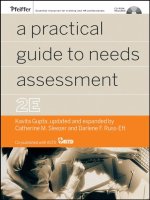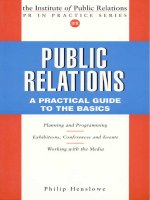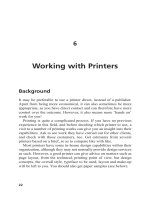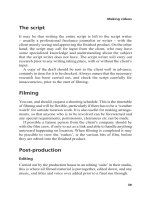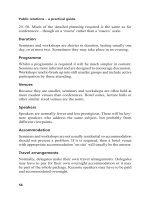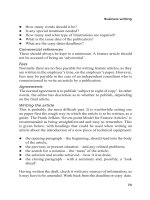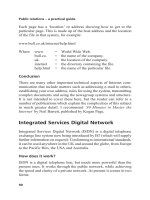Online Public Relations A Practical Guide to Developing an Online Strategy in the World of Social Media PR in Practice by David Phillips and Philip Young_5 docx
Bạn đang xem bản rút gọn của tài liệu. Xem và tải ngay bản đầy đủ của tài liệu tại đây (236.89 KB, 17 trang )
73
Business writing
l How many words should it be?
l Is any special treatment needed?
l How many and what type of illustrations are required?
l What is the issue date of the publication?
l What are the copy dates/deadlines?
Commercial references
These should always be kept to a minimum. A feature article should
not be accused of being an advertorial.
Fees
Normally there are no fees payable for writing feature articles, as they
are written in the employers time, on the employers paper. However,
fees may be payable in the case of an independent consultant who is
commissioned to write an article by a publication.
Agreements
The normal agreement is to publish subject to sight of copy. In other
words, the editor has discretion as to whether to publish, depending
on the final article.
Writing the article
This is probably the most difficult part. It is worthwhile setting out
on paper first the rough way in which the article is to be written, as a
guide. The Frank Jefkins Seven-point Model for Feature Articles is
recommended as being straightforward and easy to remember. This
is given below, with headings that could be used when writing an
article about the introduction of a new piece of technical equipment:
l the opening paragraph the beginning, should lead into the body
of the article;
l the previous or present situation and any related problems;
l the search for a solution the meat of the article;
l the solution and results achieved how it was done;
l the closing paragraph with a summary and, possibly, a look
ahead.
Having written the draft, check it with any sources of information, as
it may have to be amended. Work back from the deadline or copy date.
319(14).p65 13/06/00, 12:5073
Public relations – a practical guide
74
Reference books
It is worthwhile having a few aids to writing: Rogets Thesaurus, a
Dictionary of quotations, the Oxford English Dictionary and a copy
of Fowlers English Usage are a good basis from which to start. You
can add any other suitable, specialist books as appropriate.
Conclusion
A good feature article, well written and illustrated, is an excellent
form of public relations, and can benefit the organization featured,
its products and its business generally. It also can benefit you, as the
author.
319(14).p65 13/06/00, 12:5074
75
Crisis management
15
Crisis Management
Crisis public relations, or crisis management as it is often called,
is a form of public relations which until comparatively recently was
little known about or even thought of. However, in recent years the
number and scale of disasters, has highlighted the need for a particular
form of public relations that enables an organization to cope with a
crisis situation whatever form it may take, and come out of it with
some credibility. This chapter takes a brief look at some aspects of
crisis and how to plan for them, with a checklist of things to remember
if the worst occurs (see Appendices 15 and 16).
Lack of crisis management or planning can have a devastating effect
on an organizations image, its credibility, its reputation, and on the
morale of its employees; whether it is the government of a country, a
multinational corporation or a small company. Because very often
the organization is not seen to be in a high risk business in the
strictest sense, does not mean that there will never be an occasion
when it will not experience an emergency of some sort. It is well to
be prepared.
319(15).p65 13/06/00, 12:5075
Public relations – a practical guide
76
What is crisis management?
Crisis management is the ability to cope, with any emergency situation
that may arise in such a way that the minimum amount of damage
is caused to the organization in whatever context that may be. Any
organization that has the misfortune to experience an emergency
situation, of any sort, must not only be able to cope, but must be seen
to be able to do so. Otherwise it will suffer damage, in terms both of
its image and its credibility, not only with its own workforce but also
with the public.
How to cope
Often the first reaction to a crisis situation is one of panic, followed
by confusion. Certainly, the first stages of any crisis situation are
usually ones of apparent chaos. Information is at best vague or more
likely non-existent. Rumours, abound, whipped up by the media in
search of a good news story. If it is a situation where there has been
loss of life (a major explosion, or a fire) there will be additional
problems of trying to find out who is missing and informing friends
and relatives.
An enormous volume and variety of detail has to be dealt with
quickly, calmly and efficiently. Just how does one cope? Knowing
how to deal with such a situation, and then dealing with it well, is the
key. It can be done, and done in such a way as to turn the situation to
advantage; at the very least to limit any damage to a minimum.
What follows are some of the basic rules that apply whatever form
a crisis may take and if you follow them you will be prepared.
Obviously details will vary with each situation, but the principles
remain the same. These, then, form the infrastructure, or skeleton,
for the management of a crisis situation.
Assess
Look at your organization as objectively as possible. Try and imagine
a situation that could arise: a major explosion in a factory, an outbreak
319(15).p65 13/06/00, 12:5076
Crisis management: establish crisis centre
319(15).p65 13/06/00, 12:5077
Public relations – a practical guide
78
of food poisoning, a bomb at a mainline railway terminus, a fire in a
shopping precinct. These are the sorts of scenarios that could affect
your organization and its reputation. Think of it as the What if. . .
situation.
Plan
Draw up contingency plans, however simple, to cover different
possible scenarios. Each plan may have to be different, but it may be
that one plan can be adapted to suit all potential crises.
Prepare
Earmark suitable premises as a crisis operations centre and appoint
key staff; allocate their tasks and responsibilities. Good communica-
tions are vital in any crisis situation, so look at what communications
facilities you have available. Decide what else you will need. Dedicate
separate direct telephone lines and equipment before the crisis occurs.
Train
Practise with all those involved in the team so that they become
familiar with what they have to do, when, and how. Quick response
is critical in the early stages of any crisis. Train and train again.
Modify
No plan will last forever. Situations, people, circumstances all change.
Therefore remember to update or modify your plan at regular intervals
to meet these changes.
After it is over
The aftermath of a crisis can sometimes be messy and protracted.
There is often much to be cleared up, both figuratively and literally.
The life and work of your crisis team may have to be extended, albeit
in a different form, to cope with it all. There will also most likely be
a complicated and lengthy inquiry, with evidence to be collected, all
319(15).p65 13/06/00, 12:5078
79
Crisis management
of which will involve much work by the organization and your team
members.
Careful and skilful handling of all the public relations issues
involved can considerably lessen any lingering stigma and false
impressions that may have been created.
319(15).p65 13/06/00, 12:5079
Public relations – a practical guide
80
16
Working with the Media
The media, or broadcast media as it is usually called, is different from
the press. It has special advantages and disadvantages. Radio and
television have one thing in common: they are both transient unless
recorded, unlike newspapers which can be read again and again. The
content of newspapers may date very quickly (yesterdays news is
history), but they can be stored and retrieved at will. Properly used,
the media can be extremely valuable in public relations terms, in
getting particular messages across to a wide audience, provided that
its special attributes are understood.
Impact
There is a lot more to broadcasting and the role for public relations in
the media than merely sending news releases to radio and television
stations. It must be remembered that, unlike the printed word, broad-
cast messages are somewhat difficult to retain. However, they do have
an instant impact, eg a natural disaster such as an earthquake. But
because of their transience, broadcast messages can often be misunder-
stood or quickly forgotten.
319(16).p65 13/06/00, 12:5180
81
Working with the media
Audiences
Television and radio have huge audiences, even bigger than before
with the advent of satellite communication. For instance, CNN news
is seen by hundreds of millions of people all over the world today,
thanks to the use of satellite broadcasting techniques and equipment.
For many years the BBCs World Service has broadcast to millions
of listeners in all parts of the world, in their own language as well as
in English, and it is still very popular today.
In the UK alone network television attracts up to 40 million viewers,
more than 25 per cent greater than the combined total readership of
all our national daily papers.
Television
There are some major characteristics about television that should be
remembered:
l Some programmes are still broadcast live, but most are pre-
recorded.
l Some programmes are made months in advance of transmission.
l Material can be held over for future use.
l Editing can break up a sequence or alter the meaning.
l Planning requirements for programme making are demanding
(research, locations, lighting, equipment and engineering).
Public relations practitioners must be aware of and understand these
technicalities and characteristics.
The down side
Be aware also of some of the pitfalls. Television is often used to amuse
and entertain, rather than to inform its audience. So, care and consider-
ation when planning television work is important. Make sure that the
right type of programme is selected. Do not use television just because
of the glamour associated with the medium vanity can prove costly
and damaging!
319(16).p65 13/06/00, 12:5181
Public relations – a practical guide
82
Opportunities for coverage
using television
News bulletins National and regional.
Magazine programmes Regular features. Open to material that
is both topical and of interest to partic-
ular groups (ie motorists, farmers,
businessmen).
Chat shows/interviews Participation by personalities, especially
and discussions if their subjects are interesting.
Serials and Soap Subjects of public concern and interest
Operas can be worked into these in a fictional
setting: drugs in Eastenders, marriage
problems, adoption and transplant
ethics in Coronation Street, various
topical crime issues in The Bill,
farming topics on Country File.
Current affairs Can be very useful to put over major
programmes issues. May require cooperation from
the public relations practitioner in
covering the subject matter, or may be
interested in a proposed topic.
Series Material may be produced well in
advance and appear at regular intervals.
Library shots External shots may be borrowed or
hired: landmarks, special locations etc.
Archival material Film, video or still photos inserted
into the programme as background
material for scene setting. Fees may be
payable.
319(16).p65 13/06/00, 12:5182
83
Working with the media
Documentary file material
You may have film, video or still material that is of interest, which
could be shown in full or in part. Acknowledgements are given and
royalty fees paid. The latter are usually negotiable.
Fees and rates
The rate for fees and royalties varies, but are normally negotiated at
a rate per minute or part thereof. This will differ depending on where
the programme is to be shown, but as an example:
l UK only: £200 per minute or part thereof.
l International distribution: £400 per minute or part thereof.
Radio
One of the great advantages of radio over television is that it is not
confined to indoor audiences. It is a highly portable medium,
particularly since the advent of the Walkman belt-portable radios,
the clockwork powered radio and other very small portables. For this
Properties Properties and materials used in
television films are usually credited at
the end.
Products These are not credited, but have none-
theless been seen by viewers.
Stills Slides and pictures are often used for
rostrum camera work on programmes.
Prizes The give-aways on quiz shows. If
recognizable, they can be useful in
public relations to propose their use to
the producer.
319(16).p65 13/06/00, 12:5183
Public relations – a practical guide
84
and other reasons it is less restrictive than television. It is also more
adaptable and quicker to produce, requiring fewer facilities.
The radio does not require an immobile audience. It can be listened
to whilst doing other things, is often used as a background companion
for the elderly, the housebound or for blind people, and is usually
better for music programmes as it can be listened to continuously.
It is also more responsive than television. It can broadcast matters
such as local road conditions, weather warnings or emergency
announcements very quickly. Local radio can cover local areas, and
issues, much more effectively and intimately than even regional
television.
Opportunities for coverage using radio:
News bulletins National, regional and local news coverage.
Taped interviews Done in several ways. The station may
commission an interview, or it can be made
by the company and supplied to the stations.
If the latter, no commercial references
should be made during the interview but the
company name will normally be given at the
start and the finish.
Studio interviews, Interesting people, conversationalists,
discussions, talks commentators and interesting voices are all
good potential radio material.
The phone-in Much used on local radio and increasingly
popular. Can be done down-the-line from
the office or the home.
Serials, series, Public relations messages can be put over on
soap operas these programmes as with TV. The Archers,
for example, often carries important messages
about farming and related agricultural
matters.
319(16).p65 13/06/00, 12:5184
85
Working with the media
Teletext and Ceefax
These are extensions to television available to those whose sets have
the facilities to receive them (ie most households). They are effect-
ively a visual magazine programme, covering a wide variety of
different topics and giving information which the viewer can call up
at will. Teletext and Ceefax are the two principal channels available
on terrestial TV at present in the UK but, with the advent of cable
television and satellite television, more are becoming available.
They cover a variety of topics, such as the weather, stock exchange
prices, traffic conditions, sports results, news, entertainment, shopping
prices, farming prices and travel booking opportunities. Currently,
both are being updated, modernized and made easier and more attract-
ive to use, with some visual aids.
Viewdata
This is another form of visual information. Here, too, there are several
different systems online.
Prestel
Prestel is the BT system. This has a great deal more information than
Teletext, with public relations and commercial information supplied
to the Prestel computer from a large number of different sources. The
viewer can request specific information and there is a talk-back facility.
Prestel works through a television set, but needs a special adapter
and has to be connected to the telephone system.
Local call rate charges have to be paid to use the service. Costs are
high general pages are free but specific information is charged for,
plus the cost of the call. There are firms that will produce page
information for clients. It can provide similar information to online
airline reservation information.
Unitel
Unitel is produced by the Universal News Service (UNS), on the
Prestel system. It provides its clients with a nationwide distribution
319(16).p65 13/06/00, 12:5185
Public relations – a practical guide
86
of news of local and specialized interest, thus enabling public relations
officers to reach the local media instantly, instead of issuing huge
numbers of news releases. Editors in newsrooms all over the UK can
receive news directly relevant to their own circulation areas. A single
call to UNS gets immediate and cost-effective service via Unitel using
the Prestel system and offline printers. Most regional editors now
receive instant news on this system, and can call up stories applicable
to the region on screen. The selection is then made and the story is
screened complete with any contracts. Using a screen image printer,
the whole story can then be printed out immediately. It costs nothing
the editor has free access to every story on UNS files.
319(16).p65 13/06/00, 12:5186
87
New developments in technology
17
New Developments
in Technology
Information technology (IT) is changing rapidly, not just in computing
but in communications generally, and there are new concepts coming
into service that will have a major impact on public relations work.
These new concepts are being developed as the IT industry continually
refines and expands the range of its products and services. This chapter
describes three of these new concepts and how they will alter the
way we work in future.
The Internet
Originating in the USA, the Internet is simply a network of linked
computers, each one connected to a set of others, supporting the
electronic communication between computers around the world. The
Internet has grown to encompass universities, businesses and finally
governments, worldwide. There are now estimated to be 50 million
Internet users and that number is rising with services accessible
in almost every country. These networks might be local, linking all
the computers belonging to a single company or organization; or they
can be a much more sophisticated, wider regional, or even national
network, linking large institutions and organizations.
319(17).p65 13/06/00, 12:5287
Public relations – a practical guide
88
Also known as the Worldwide Web, the Internet is having an enor-
mous impact and influence on communication methods and techniques
worldwide, both as a marketing and a public relations business tool.
Although some see it as a simple method of communication, to the
uninitiated it can appear confusing.
Uses of the Internet
Principally, it is used in the following ways:
l Research: To learn about new developments, techniques, meth-
ods, products, competitors and customer opinion.
l Communication: To provide digital correspondence, either elec-
tronically (e-mail) or through the telephone.
l Trading: Supporting electronic advertising, selling and marketing
of goods and services worldwide.
In public relations terms, the Internet is having a rapidly growing
impact, and it is starting to play a significant part in our work, with
many implications for those who use it. It is increasingly used to
communicate both for private and work purposes.
Electronic mail
The advent of the Internet has led to many organizations, businesses
and individuals having electronic mailing links. Electronic mail (or
e-mail) is a way of communicating that can be used for internal
purposes within a large organization, or more generally for a wider,
external audience. The latter takes the form of addresses on the
Internet, or sometimes even their own home page, giving information
which is available to all and sundry. Newspapers, television stations
and even some programmes all now quote Web addresses.
Universities, colleges, schools, institutions and public bodies can all
now communicate immediately with each other, often exclusively,
using the Web.
319(17).p65 13/06/00, 12:5288
89
New developments in technology
Controls
Because it is used to advertise, communicate and even sell goods and
services, to communicate internally by large organizations with their
subsidiary companies and by universities, schools and colleges to
gather and exchange information, copyright and the control of access
are just a few of the issues being raised. In addition, because many
businesses now carry pages with a large amount of information
instantly available to anyone who taps into it, security of information
has become a major issue.
Surfing
It also attracts individuals who simply surf the Internet, trawling
for all kinds of information for their own, mostly private, use. This
surfing has raised all kinds of issues as to how the Internet can be
controlled, or even policed, in the present and foreseeable future.
Distribution
Electronic mail is supported by many office automation suites to allow
documents, including pictures, spreadsheets and presentations, to be
distributed on the World Wide Web.
The World Wide Web
This is a way to make accessing information within Internet systems
easier. Information is structured in a wide variety of pages, such as:
l Formatted text with titles, sections etc.
l Pictures in a variety of formats.
l Sounds also in a variety of formats.
l Applets animated information.
l Forms for completion by the user requesting further information,
or services.
319(17).p65 13/06/00, 12:5289

